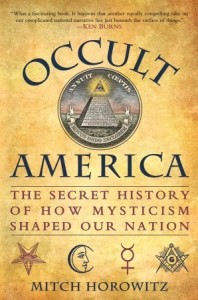 Occult America could have more accurately been titled Occult Roots of the New Age. The focus of this book is on identifying progenitors of phenomena familiar to the mainstream, such as Ouija boards and the daily newspaper horoscope, rather than linking true twenty-first century occult to any historical American perspective. The expected cast of characters appears, including Joseph Smith, Mme. Blavatsky and Edgar Cayce, along with less familiar names such as mail order mystic Frank B. Robinson or scholar of ancient sciences Manly P. Hall.The foundation of the book is an in-depth look at the Burned-Over District, a swathe across New York State from Albany to Buffalo that was a magnet for unorthodox religious study for about 100 years, starting in the late eighteenth century. So many prophets, mystics, spiritualists, and firebrand preachers traveled through this area that it was said to be “burned over” with religious fervor. I recently made a brief foray into the Burned-Over District while publicizing my own book and I will probably at some point devote an entire post to the history of this fascinating area.Occult America also explores the occult influence in government, and it seems in this regard there is always something new to learn. Many people are aware that some of the Founding Fathers were Freemasons, and that Ronald Reagan took the advice of his astrological advisors very seriously, but the occult influence on the Lincoln and Roosevelt White House is less well known.Horowitz does not shrink from describing the unsavory side of spiritualist movements, especially the pro-fascist Silver Shirts of the Depression and World War II era. He gives a balanced view of Edgar Cayce, acknowledging the typically enlightened yet at times prejudiced nature of the material that came through him.In a chapter on the African American influence on New Age, Horowitz mentions the practice of hoodoo and nearly veers into actual discussion of the occult, but he pulls himself back in time. A person who can walk into an occult store and understand the uses of the various herbs and implements sold there might very well wonder what, if anything, this book has to do with them. The magical legacies of the Pennsylvania Dutch, or New Orleans Voodoo, or Southwestern curanderos are not discussed. The role of America in the popularization of witchcraft is dealt with in one dismissive page. The Goddess Movement is ignored completely. Horowitz is concerned with how the occult shaped conservative and mainstream America. The value of this book for someone with a more sophisticated understanding of the occult is that it shows some common roots to very disparate twenty-first century spiritual philosophies. It filled in a lot of gaps in my knowledge. Though Witches, Pentecostals and New Agers see themselves as very different, they seem to have branched from the same tree.
Occult America could have more accurately been titled Occult Roots of the New Age. The focus of this book is on identifying progenitors of phenomena familiar to the mainstream, such as Ouija boards and the daily newspaper horoscope, rather than linking true twenty-first century occult to any historical American perspective. The expected cast of characters appears, including Joseph Smith, Mme. Blavatsky and Edgar Cayce, along with less familiar names such as mail order mystic Frank B. Robinson or scholar of ancient sciences Manly P. Hall.The foundation of the book is an in-depth look at the Burned-Over District, a swathe across New York State from Albany to Buffalo that was a magnet for unorthodox religious study for about 100 years, starting in the late eighteenth century. So many prophets, mystics, spiritualists, and firebrand preachers traveled through this area that it was said to be “burned over” with religious fervor. I recently made a brief foray into the Burned-Over District while publicizing my own book and I will probably at some point devote an entire post to the history of this fascinating area.Occult America also explores the occult influence in government, and it seems in this regard there is always something new to learn. Many people are aware that some of the Founding Fathers were Freemasons, and that Ronald Reagan took the advice of his astrological advisors very seriously, but the occult influence on the Lincoln and Roosevelt White House is less well known.Horowitz does not shrink from describing the unsavory side of spiritualist movements, especially the pro-fascist Silver Shirts of the Depression and World War II era. He gives a balanced view of Edgar Cayce, acknowledging the typically enlightened yet at times prejudiced nature of the material that came through him.In a chapter on the African American influence on New Age, Horowitz mentions the practice of hoodoo and nearly veers into actual discussion of the occult, but he pulls himself back in time. A person who can walk into an occult store and understand the uses of the various herbs and implements sold there might very well wonder what, if anything, this book has to do with them. The magical legacies of the Pennsylvania Dutch, or New Orleans Voodoo, or Southwestern curanderos are not discussed. The role of America in the popularization of witchcraft is dealt with in one dismissive page. The Goddess Movement is ignored completely. Horowitz is concerned with how the occult shaped conservative and mainstream America. The value of this book for someone with a more sophisticated understanding of the occult is that it shows some common roots to very disparate twenty-first century spiritual philosophies. It filled in a lot of gaps in my knowledge. Though Witches, Pentecostals and New Agers see themselves as very different, they seem to have branched from the same tree.
